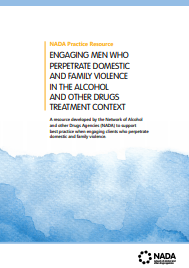 A NADA practice resource (2021)
A NADA practice resource (2021)
Effective, integrated treatment for AOD issues needs to include support for clients to develop healthy relationships. The use of domestic and family violence (DFV) severely harms the potential for healthy relationships, including for the perpetrator. This resource aims to support AOD practitioners to work safely and effectively with clients who perpetrate DFV and to become familiar with suitable pathways for specialist support. It is not intended to be a comprehensive guide to addressing behaviour change with people who perpetrate DFV, as it is acknowledged that this is a specialist area of work.
Download this resource [PDF]
While DFV comes in many forms and can be used and experienced by any gender, research has shown that men are by far the most common perpetrators of DFV, and cause the most harm. This resource therefore focuses on engaging adult male clients who perpetrate DFV.
Click the ‘videos’ tab above to watch accompanying videos.
Watch these recorded webinars
These videos should be viewed in conjunction with this resource:
Engaging men who perpetrate DFV in the AOD treatment context
This webinar is the first in a series that explores NADA’s Engaging men who perpetrate DFV in the AOD treatment context practice resource. This resource and series of videos aim to support the AOD workforce with practical skills and knowledge to work safely and effectively with clients who perpetrate DFV and to become familiar with suitable pathways for specialist support. Though DFV is a highly specialised area, and not core business for AOD services, it is important that the workforce build capacity to better respond to people who use DFV and work alongside other service sectors, to address this very serious problem.
Engaging men who perpetrate DFV in an AOD treatment context—practical techniques and considerations for minimising collusion
Collusion, within the context of DFV, occurs when a practitioner, agency or system excuses, minimises or justifies a perpetrator’s violence towards family members. Collusion can take many forms—at a practitioner level it can be expressed through a nod of agreement or a sympathetic smile (whether inadvertent or deliberate) when a man expresses a violence-supporting attitude or belief. This webinar features a panel discussion that explores collusion, what it is and provides a starting point for how to have safe and non-collusive conversations with clients who cause. The webinar presents a role play demonstrating an AOD practitioner having a conversation with a client that minimises collusion, when the client tries to justify, minimise and excuse his use of DFV.
Engaging with clients causing DFV harm during the COVID-19 pandemic
The COVID-19 pandemic has presented new challenges and complexities in working with clients who perpetrate DFV and it has been widely recognised that rates of DFV increased during COVID. This webinar explores how AOD services and practitioners can help keep a client who is causing DFV harm within view when providing telehealth support and identify and manage the risk they pose to family members.



